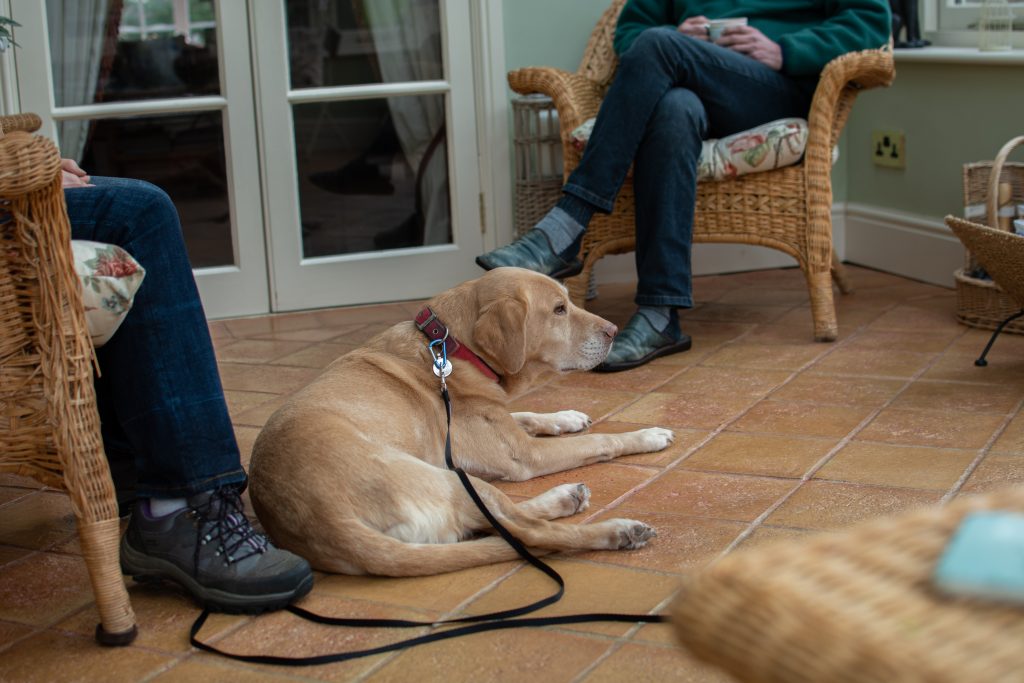Using a House Line
 Caroline Clark, Pet Education and Training
Caroline Clark, Pet Education and TrainingThe house line is a useful way of managing and safely controlling your dog without using force or direct physical contact/attention. It is a method of training and should not be used solely as a long term solution to a behaviour problem.
Times when you may need to use a house line include:
- Removing the dog from furniture/bed.
- Moving the dog away from or out of the way of something.
- To control the dogs movements safely.
- To move the dog without reinforcing attention seeking behaviour.
- To back up a cue.
Benefits
The houseline reduces the need to invade your dog’s space, grab or push them around which can be quite threatening. It also reduces conflict (e.g. for any resource guarding issues) and for dogs that seek attention it provides you with a means of controlling them without making any physical or eye contact.
What are they?
A houseline is a training aid – usually around 2.5 metres long and shouldn’t be confused with a recall or long line.
They can be purchased from most pet shops or via online stores and are virtually the same as a puppy line -used to housetrain youngsters.
The design and type of material used are less likely to become tangled up in furniture so can be left to trail on behind a dog but ONLY when they are under your constant supervision.
- 10ft 3m Puppy Training Lead Recall Obedience Leash Available in Black
- These are Perfect Recall Training and Distance work Leads giving your Dog the freedom to run whilst being under control and safe.
- The floating 13mm D-Ring in the handle is designed to half the length of the lead if required for close and controlled walking
- These Puppy Leads can be used in a multitude of environments such as outside gardens, beach walking, fields, camping areas, parks Etc
- PUPPY TRAINING: Helps stop unwanted behaviour and makes puppy training easy!
- LIGHTWEIGHT: This lightweight lead is used in the house to interrupt a dog’s undesirable behaviours without the need for confrontation or misunderstanding
- HOUSE & INDOOR: Indoor training lead used to help stop unwanted behaviour
- TEACH MANNERS: Designed to help interrupt unwanted behaviours such as stealing, jumping and sitting on the furniture
I may receive commission when you click Amazon links on this page and make a purchase. However, this does not impact my recommendations, reviews or comparisons.
NEVER use a houseline when the dog is unsupervised or if they have a neck/spinal injury or any issues with their joints.
The Training
The houseline is attached to the collar (not a choker) with a normal leash clip. Because the designs are modelled on a puppy line – the clip can be too small to fit the ring on the adult collar so I use a carabiner. The houseline is then left attached on the collar but ONLY when you can closely supervise them!
Before using the houseline in a real-life scenario it is important to begin with simple recall training in circumstances when they are likely to come to you (i.e. not when they are guarding for example). Following steps 1 and 2.
Always praise and provide a reward so they get used to responding and know they get something of value for complying.
Once they are consistently recalling you can begin using them in different contexts – following the steps from 1 to 7.
The Steps
- Take up the end of the houseline avoiding eye contact.
- Turn around and walk away from your dog but do not pull or yank the end and call your dog
- Call your dog and give a simple cue using a gentle tone of voice. For example: ‘Holly, off’ if you want the dog to get off the furniture or stop jumping up at visitors OR use ‘Come away’ if you need them to come away from something. Be consistent with your language.
- When your dog responds to the cue given, mark the behaviour saying: “YES” and give immediate praise or a reward they particularly like – such as a food treat/toy (especially important in early stages of training).
- If the dog fails to comply repeat the request, still using a calm tone and act in a relaxed manner.
- If the dog fails to respond, the line is now tensed and a couple of gentle tugs are used to dislodge them – giving the cue so that they can associate that word with the action.
- Reward the dog for the desired response immediately (e.g. when all 4 paws on the floor).
Other Important Information
- Ensure that you do not turn to look at your dog (even if they are reluctant to move) until they perform the desired behaviour and the reward is being given. Pulling at the dog whilst staring at them can be very challenging and some dogs will take this as a direct threat and may become aggressive/fearful.
- Try and remain calm and emotionless throughout this training and if your dog does not respond do not allow your voice to get louder or threatening.
- To avoid injury or inducing a fear response, be gentle but persistent when applying pressure on the line. The aim is to teach the dog that resistance to your cue is pointless but the line should not be associated with pain or appear threatening.
- It is not uncommon for dogs to resist the houseline in the early stages of training but it is uncommon to see aggression. If you are having difficulties or are concerned, stop using the houseline and contact me/your suitably qualified behaviour counsellor as soon as possible.

